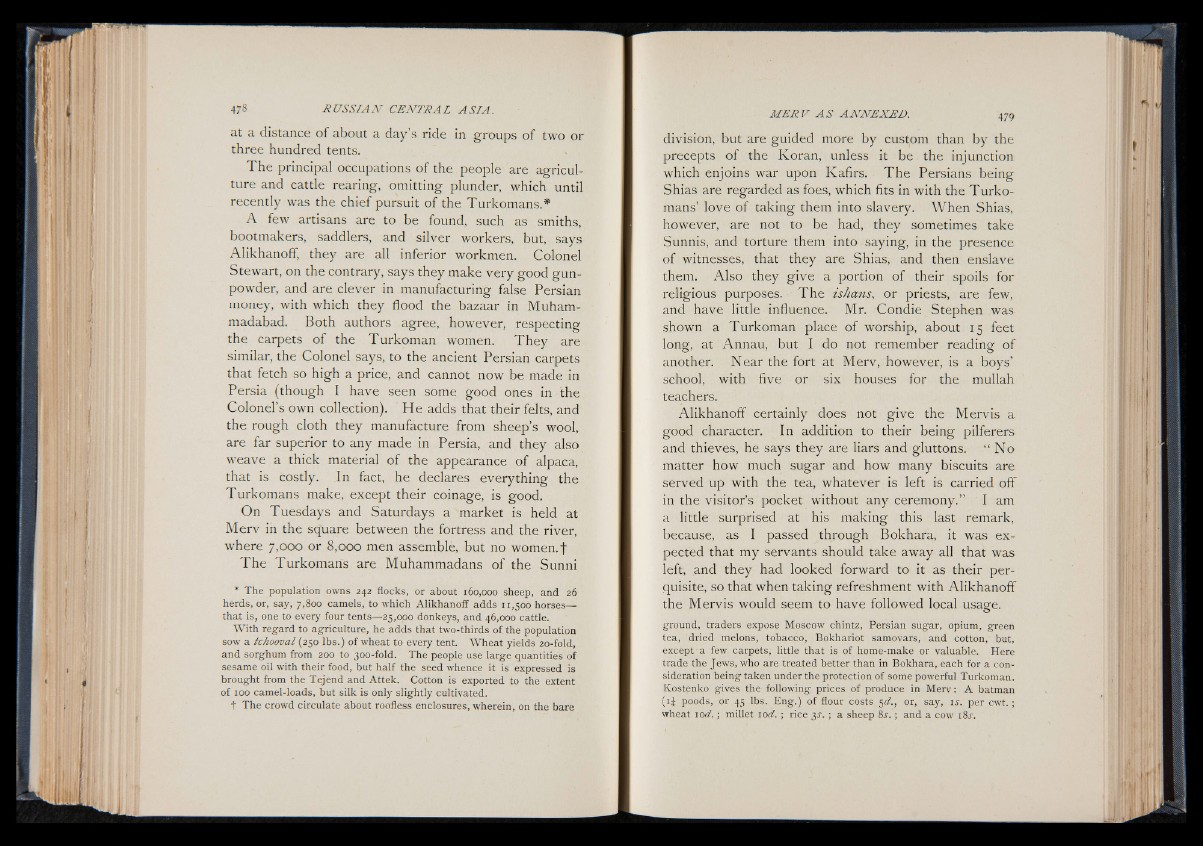
at a distance of about a day s ride in groups of two or
three hundred tents.
The principal occupations of the people are agriculture
and cattle rearing, omitting plunder, which until
recently was the chief pursuit of the Turkomans.*
A few artisans are to be found, such as smiths,
bootmakers, saddlers, and silver workers, but, says
Alikhanoff, they are all inferior workmen. Colonel
Stewart, on the contrary, says they make very good gunpowder,
and are clever in manufacturing false Persian
money, with which they flood the bazaar in Muham-
madabad. Both authors agree, however, respecting
the carpets of the Turkoman women. They are
similar, the Colonel says, to the ancient Persian carpets
that fetch so high a price, and cannot now be made in
Persia (though I have seen some good ones in the
Colonel’s own collection). He adds that their felts, and
the rough cloth they manufacture from sheep’s wool,
are far superior to any made in Persia, and they also
weave a thick material of the appearance of alpaca,
that is costly. In fact, he declares everything the
Turkomans make, except their coinage, is good.
On Tuesdays and Saturdays a market is held at
Merv in the square between the fortress and the river,
where 7,000 or 8,000 men assemble, but no women, f
T h e Turkomans are Muhammadans of the Sunni
* The population owns 242 flocks, or about 160,000 sheep, and 26
herds, or, say, 7,800 camels, to which Alikhanoff adds 11,500 horses—
that is, one to every four tents— 25,000 donkeys, and 46,000 cattle.
With regard to agriculture, he adds that two-thirds of the population
sow a tchocrval (250 lbs.) of wheat to every tent. Wheat yields 20-fold,
and sorghum from 200 to 300-fold. The people use large quantities of
sesame oil with their food, but half the seed whence it is expressed is
brought from the Tejend and Attek. Cotton is exported to the extent
of ioo camel-loads, but silk is only slightly cultivated,
t The crowd circulate about roofless enclosures, wherein, on the bare
division, but are guided more by custom than by the
precepts of the Koran, unless it be the injunction
which enjoins war upon Kafirs. The Persians being
Shias are regarded as foes, which fits in with the Turkomans’
love of taking them into slavery. When Shias,
however, are not to be had, they sometimes take
Sunnis, and torture them into saying, in the presence
of witnesses, that they are Shias, and then enslave
them. Also they give a portion of their spoils for
religious purposes. The ishans, or priests, are few,
and have little influence. Mr. Condie Stephen was
shown a Turkoman place of worship, about 15 feet
long, at Annau, but I do not remember reading o f
another. Near the fort at Merv, however, is a boys’
school, with five or six houses for the mullah
teachers.
Alikhanoff certainly does not give the Mervis a
good character. In addition to their being pilferers
and thieves, he says they are liars and gluttons. “ No
matter how much sugar and how many biscuits are
served up with the tea, whatever is left is carried off
in the visitor’s pocket without any ceremony.” I am
a little surprised at his making this last remark,
because, as I passed through Bokhara, it was expected
that my servants should take away all that was
left, and they had looked forward to it as their perquisite,
so that when taking refreshment with Alikhanoff
the Mervis would seem to have followed local usage.
ground, traders expose Moscow chintz, Persian sugar, opium, green
tea, dried melons, tobacco, Bokhariot samovars, and cotton, but,
except a few carpets, little that is of home-make or valuable. Here
trade the Jews, who are treated better than in Bokhara, each for a consideration
being taken under the protection of some powerful Turkoman.
Kostenko gives the following prices of produce in Merv: A batman
( ij poods, or 45 lbs. Eng.) of flour costs $d., or, say, ij. per cwt.;
wheat 10d .; millet iod. ; rice 3 .s'. ; a sheep 8j. ; and a cow i8j.